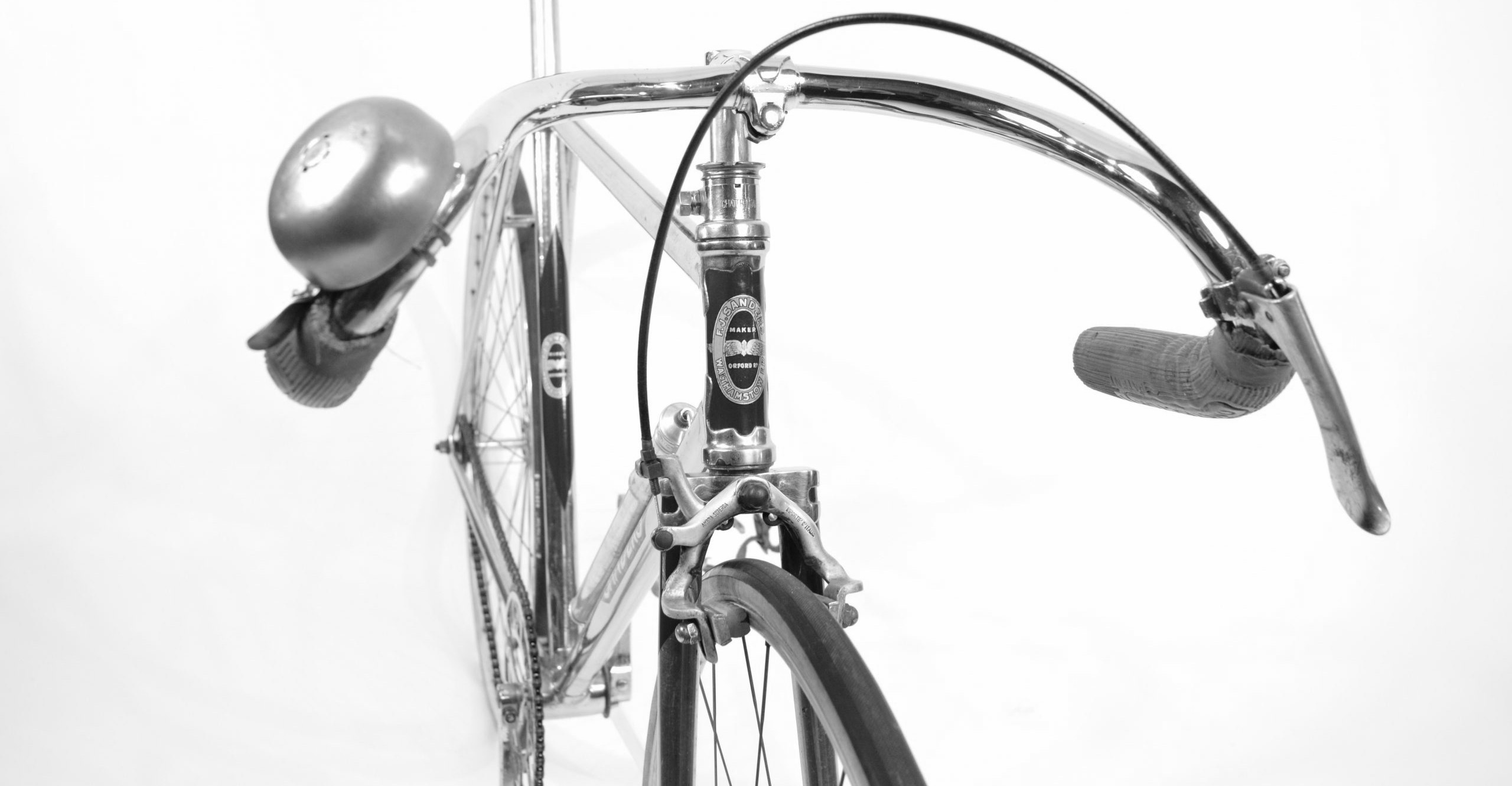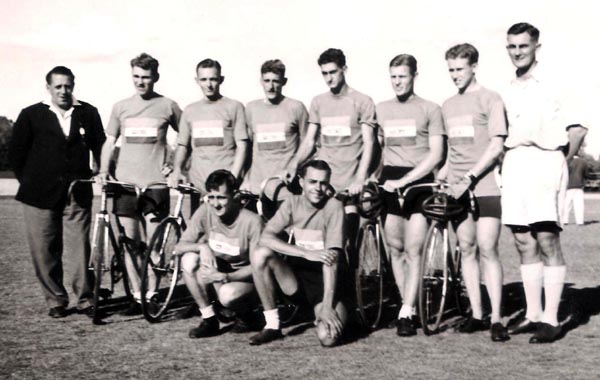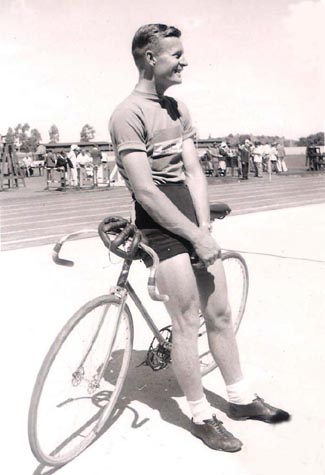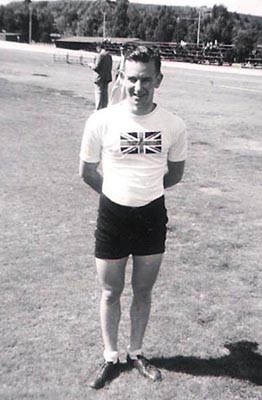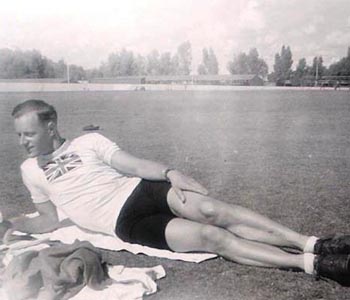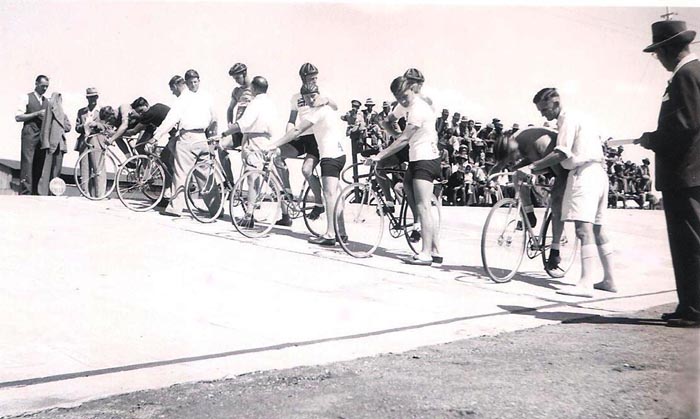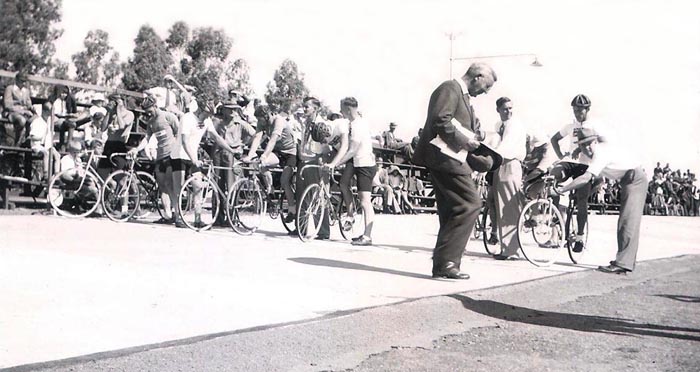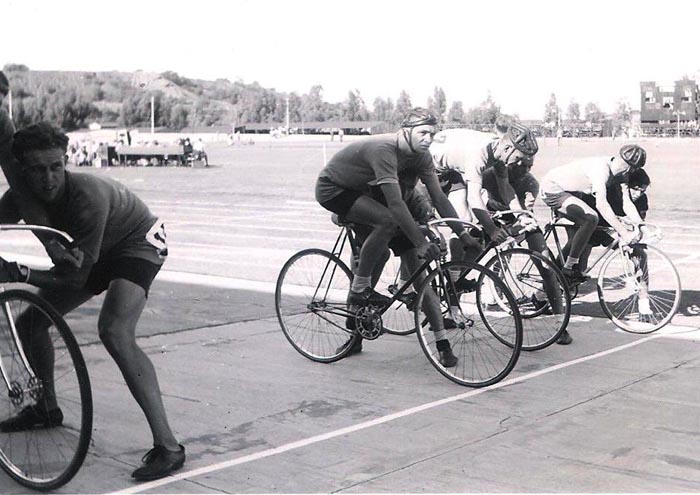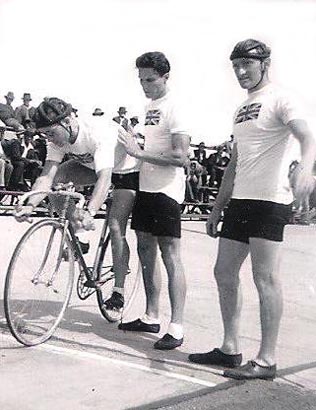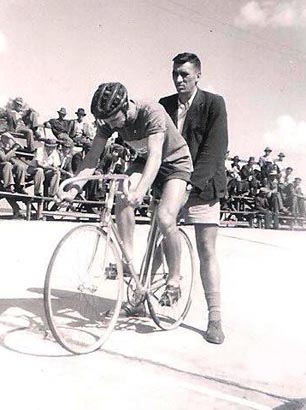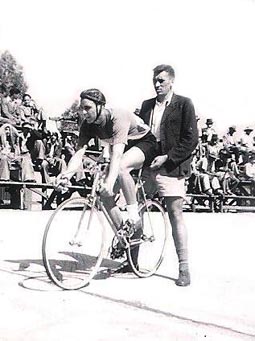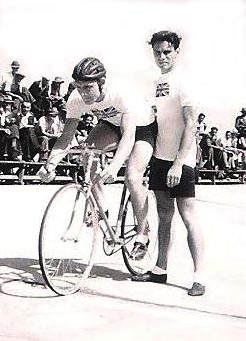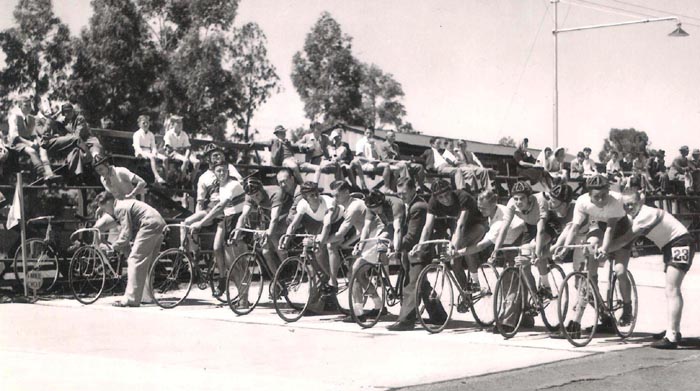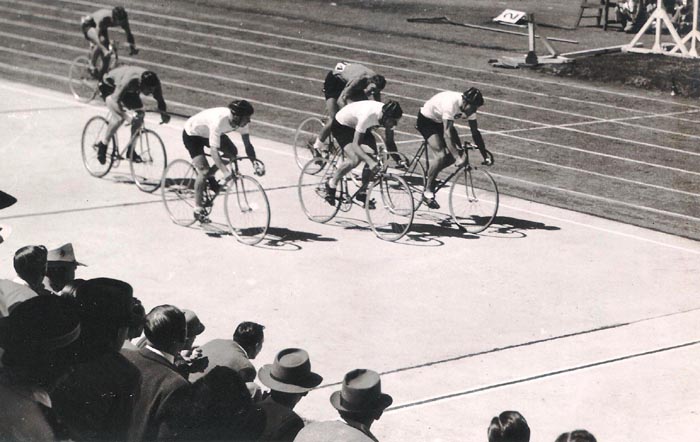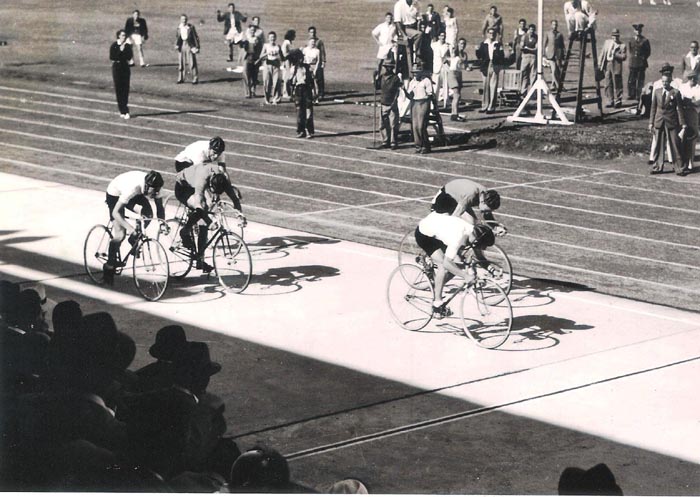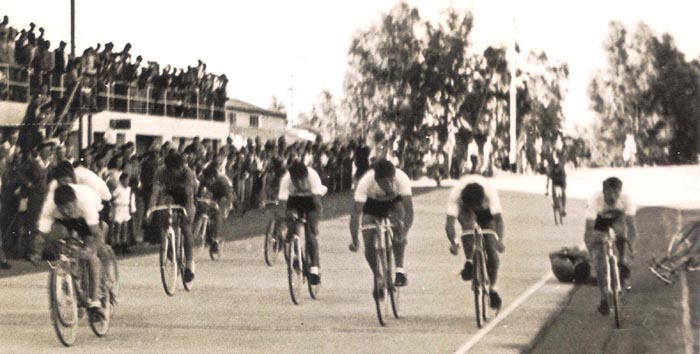The 1948 South Africa vs. Great Britain international track omnium: 'test match' at the De Beers Stadium Kimberley, South Africa
Posted: Monday 17th August 2020
Sixty four years ago, in January, 1948 – late summer in the southern hemisphere – the NCU dispatched a team of British amateur trackmen for a six week racing tour of South Africa. The squad was scheduled to compete against cyclists affiliated to the then whites–only South African Amateur Athletic and Cycling Association (SAAA&CA). The British team consisted of Lew Pond (captain), Alan Bannister, Tommy Godwin, Ron Meadwell, Dave Ricketts and Ian Scott. While it did not include the then reigning world amateur sprint champion, the mercurial Reg Harris, who had declined an invitation to be a part of the squad, its members were the youthful cream of Britain’s post–WWII amateur trackmen. 1948 was the year of the London Olympics and in travelling to South Africa the team members thus had an ideal opportunity to prepare for the Games which were to take place in July and August.
The arrival of the British track team was a novelty in South Africa for, while small contingents of SAAA&CA cyclists had competed at international level abroad at the Olympic and Empire Games before WWII, this was the first time ever that a foreign national cycling team had toured the country. As a result, local public interest was high and the track meetings featuring the British team held in various South African cities were very well attended.
However, the tour began with a track meeting in Bulawayo, Southern Rhodesia (now Zimbabwe), where there was a large RAF training base which had been established there during WWII. A big crowd was present and The Bicycle reported on the event under the headline ‘National Records Broken at Opening Meeting’, as follows:
Pond took the Rhodesian Record for 440 yards. Bannister broke the 880 yards handicap South African record. In the team pursuit the national 4,000 metres record was beaten by the British team of Bannister, Scott, Godwin and Ricketts.
Thereafter, the tourists moved onto South Africa itself where they were obliged to travel long distances by both road and rail to reach the track meetings which had been arranged for them in various centres.
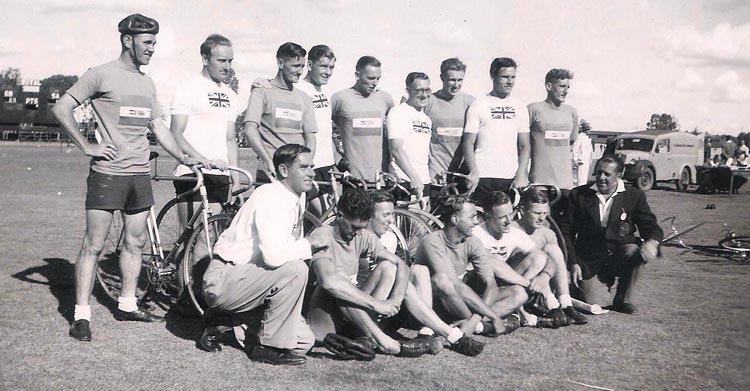
Garth ‘Faggi’ Thompson vividly recalls being at the track meeting involving the British team held in the east coast city of Durban. Staged at the city’s Lords Ground stadium, it included the inaugural Durban Grand Prix match sprint title. Faggi, who was a 12 year old schoolboy at the time, remembers the stadium being packed, with many WWII ex–servicemen in the crowd who enthusiastically drank the beer tent dry during the meeting. Despite being interrupted by rain delays, the British riders impressively won all but one of the events they contested on the day. Alan Bannister won the meeting’s centrepiece, the Durban Grand Prix match sprint title, recording an impressive final 220 yards time of 12.5 seconds on the notoriously slow, crumbling tarmac track.
But while the British team competed against local and provincial cyclists at track meetings in most of the major centres – Johannesburg, Cape Town and Durban – the tour involved only one international contest against a SAAA&CA selected South African national team. Curiously, this was staged in the town of Kimberley situated in the northern Cape province.
Kimberley is famous as a diamond mining centre but is somewhat off the beaten track. However, its big attraction to cyclists at that time was its state–of–the–art ‘velodrome’ at the De Beers Stadium. This multipurpose stadium had originally been constructed in the 1920s when the foundation stone was laid by the then deputy chairman of De Beers Consolidated Mines, the Earl of Bessborough. It incorporated a rugby field, athletics track and a 500 yard cycling track. In 1939 the stadium’s cycling track was upgraded and resurfaced in cement which made it unique amongst the country’s many outdoor tracks. These typically had slow and often uneven tarmac surfaces. The Kimberley track at the De Beers stadium was thus technically the best available choice for the first and only 1948 Great Britain versus South Africa cycling ‘test match’, as it was billed locally. That the Kimberley track was also chosen as the venue for the SAAA&CA’s national track championships in 1946, 1949 and 1950 points to its popularity amongst cyclists at the time.
In 1948, Arthur Rice was a young cycling enthusiast from the Kimberley area who was nurtured on the De Beers track. Tucked away in the Rice family photograph album, kindly recently loaned to me by his daughter, Lynne Larsen, are a series of photographic images documenting the historic 1948 Kimberley Great Britain versus South Africa cycling test match. Unfortunately many of these images are either untitled or contain only minimal information. This article attempts to reconstruct the contest they depict.
| Great Britain | South Africa |
| 1. Lew Pond (captain) | 1. Ronnie Benvenutti |
| 2. Alan Bannister | 2. Stan Chelin |
| 3. Tommy Godwin | 3. Ronny Fairall |
| 4. Ron Meadwell | 4. Jan Huyshamer |
| 5. Dave Ricketts | 5. C. ‘Ginger’ Olivier |
| 6. Ian Scott | 6. Johnny Ramsey |
| 7. Wally Rivers | |
| 8. Eddie Scholtz |
Quite why the South African team had eight members while the British team had only six remains a mystery.
The 1948 South Africa versus Great Britain track international omnium
The 1948 Kimberley track international took the form of an ‘omnium’. Track omniums involve a series of events with points being awarded in each. These points are accumulated as the meeting progresses and the individual or team with the best final points score is declared the overall winner. The omnium format was popular at track meetings in Britain during the interwar years with international track contests typically being run on an omnium basis.
Thus the 1948 British touring team would have been entirely familiar with the principles of an omnium contest. Likewise for the South African team since, from the late 19th century onwards, competitive track cycling in South Africa had mirrored British–style cycle sport.
The events in the 1948 international omnium
The Kimberley omnium consisted of the following events:
- Quarter mile (440 yards)
- One mile scratch
- 1,000 metres scratch
- 1,000 metres Individual TT
- 4,000 metres team pursuit
- Five mile
These events would also have been familiar to all the members of both teams. They were all SAAA&CA national championship events in the immediate post WWII period. In contrast, both the match sprint and 4,000 metres individual pursuit were only introduced as South African national championships titles in 1949.
Arthur Rice’s Kimberley international omnium events images follow.
Final result of the SA vs. GB Kimberley international omnium
The British team decisively won the omnium overall, scoring 32 points to South Africa’s meagre 5 points.
Under the headline ‘Kimberley – the Test Match’, the report in The Bicycle read:
South African Tour ends with Test win for England. Every event was won by the English team, 440 yards, 1,000 yards, 1–mile scratch, 1,000 metre time trial, 4,000 metres team and 5–mile. There were record times in the quarter mile, the kilo TT and the 4 kilo team, 4.57.7.
The comprehensiveness of this defeat came as a shock to the SAAA&CA. In the wake of it the national selectors revised their thinking. Of the eight South African trackmen who competed in the Kimberley omnium, only Wally Rivers was selected for the 1948 Olympics while ‘Ginger’ Olivier was chosen for the 1948 Amsterdam world championships. The dominance of the British team in the Kimberley international and their triumphal nationwide tour left a lasting impression on South African cycle sport.
Reflecting on the tour, Tommy Godwin wrote in his autobiography:
We had all trained well, lived well, shared good company, with a fantastic team spirit and a wonderful manager (South African, Cyril Geoghegan). We had had perfect hosts to perform for and great personal satisfaction for every member of the team. The whole tour could be reported in more detail with regard to experiences away from the racing and the hosting of the team at various stops. There were also our attempts to assist the local teams in how they should train, race, even to changing their positions on the bike. There were visits to diamond centres and mines and a variety of other interests.
(The Tommy Godwin Story, p.79)
The highly successful tour also undoubtedly benefited members of the British team, as several of them went on to represent Britain and to win medals at the 1948 London Olympics later in the year. At these Alan Bannister partnered Reg Harris to win silver in the tandem event in which the Italians, Teruzzi and Peroni took gold. Tommy Godwin won a bronze medal in the 1,000 metres TT behind Dupont (France) and Nihant (Belgium). Both Godwin and Dave Ricketts were members of the GB 4,000 metres team pursuit squad (along with Robert Geldard and Wilfred Waters) which finished third behind the teams from Italy and France. Internationally, the immediate post–WWII era of which the 1948 tour of South Africa was an integral part was thus a highpoint in the 20th century history of British track cycling.
Fortunately for us, Arthur Rice captured images of the Kimberley prelude to the 1948 London Olympics and preserved them in his family photograph album.
Acknowledgements
I am indebted to Arthur Rice’s daughter, Lynne Larsen, for allowing me to use these images, to Garth ‘Faggi’ Thompson for sharing his recollections of the 1948 British tour with me, and to Peter Underwood of Classic Lightweights for drawing my attention to details of the tour as contained in The Tommy Godwin Story.
I have also drawn on various sources, in particular: Walter Jowett, (1982) Centenary: 100 years of organised South African cycle racing. SACF.
Posted: Monday 17th August 2020
This article appears in the following categories.
Upcoming Events
Whether you are looking for a gentle social meet up, or a 100-mile ride browse the community’s upcoming events and plan your next weekend outing.
